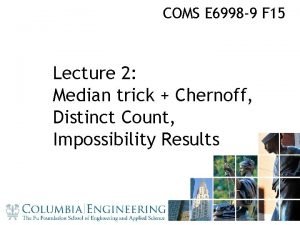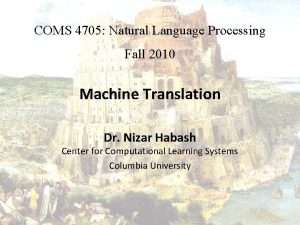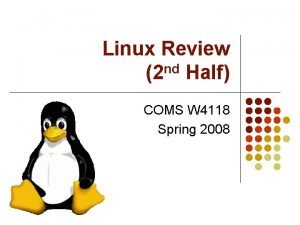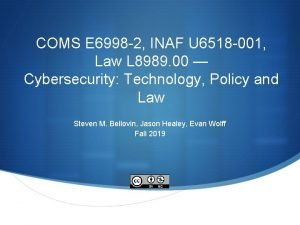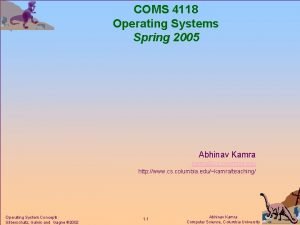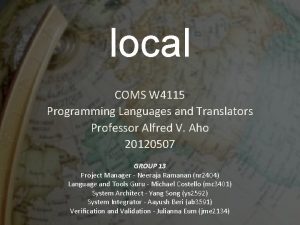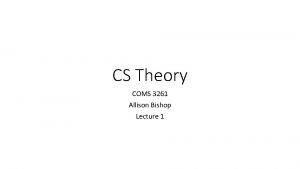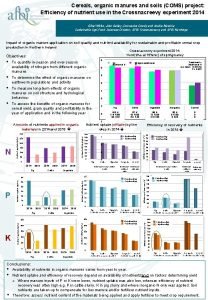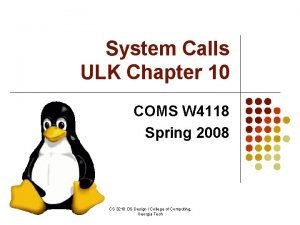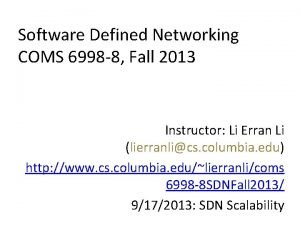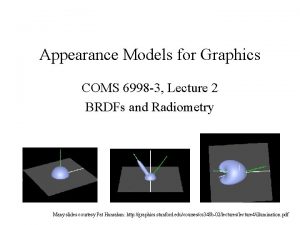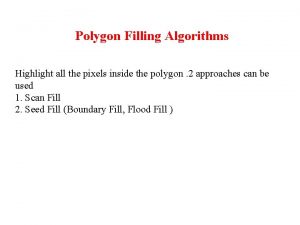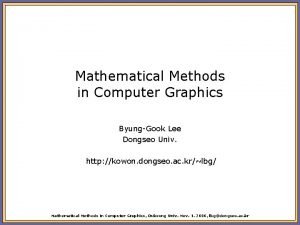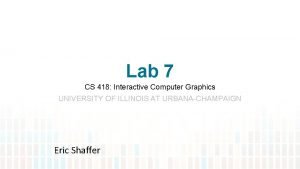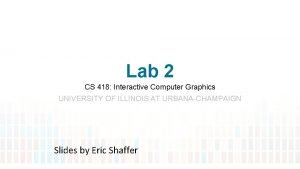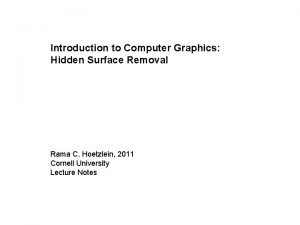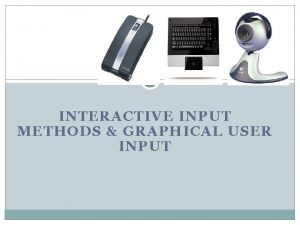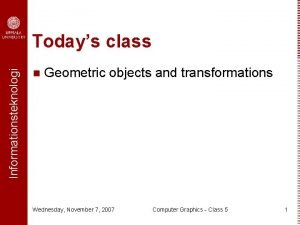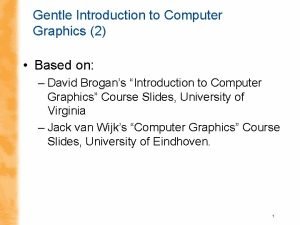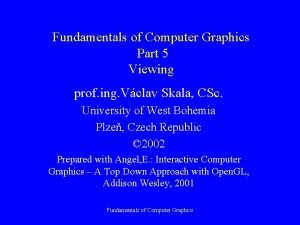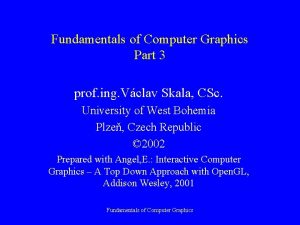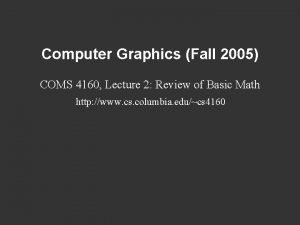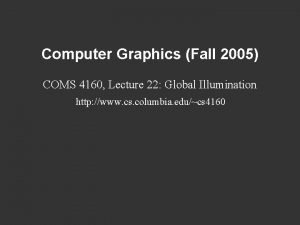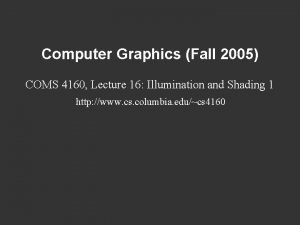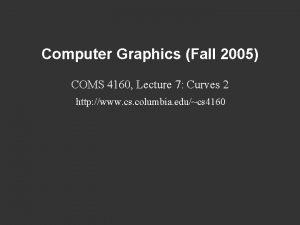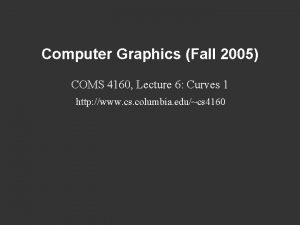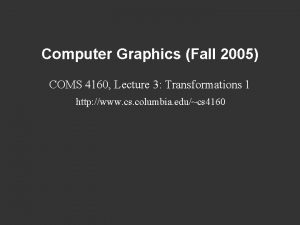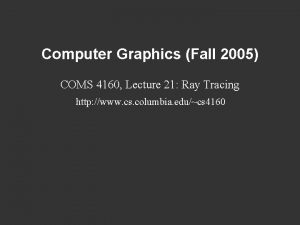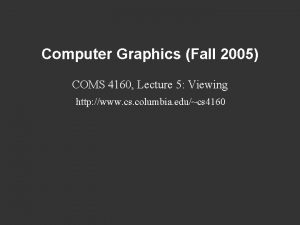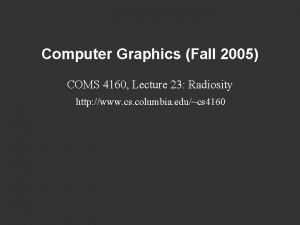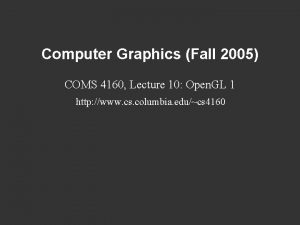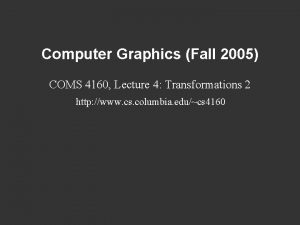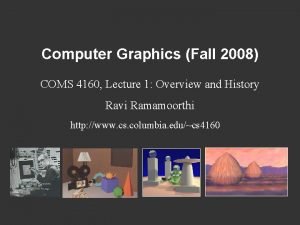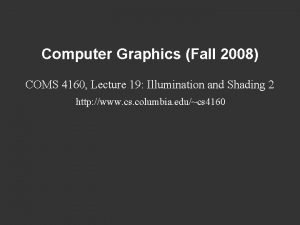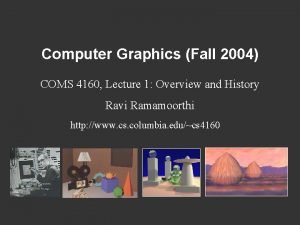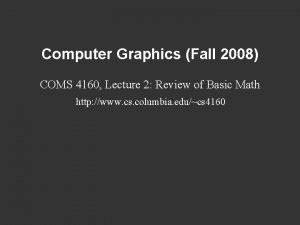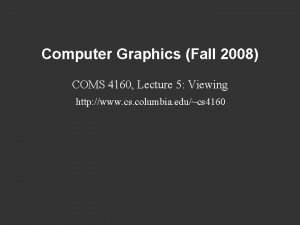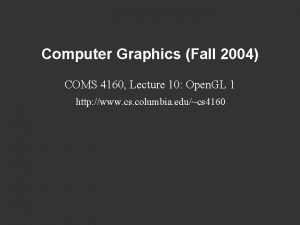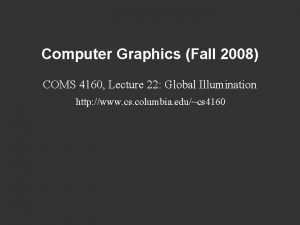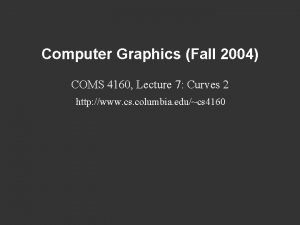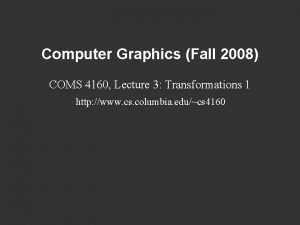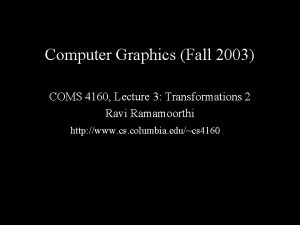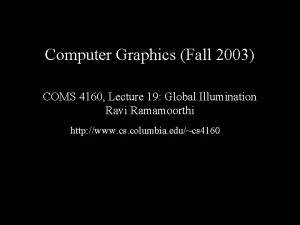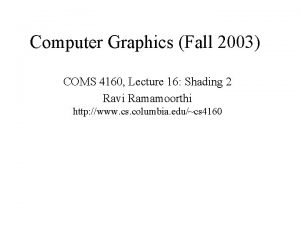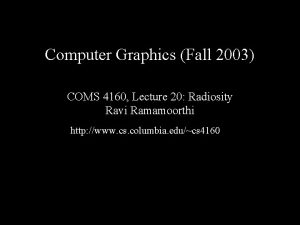Computer Graphics Fall 2005 COMS 4160 Lecture 20





![Option: Varieties of projections [Paul Bourke] Option: Varieties of projections [Paul Bourke]](https://slidetodoc.com/presentation_image/63c60d227187390b2c2a6cd968a6fa9c/image-6.jpg)
![Option: unfold the surface [Piponi 2000] Option: unfold the surface [Piponi 2000]](https://slidetodoc.com/presentation_image/63c60d227187390b2c2a6cd968a6fa9c/image-7.jpg)
![Option: make an atlas charts atlas surface [Sander 2001] Option: make an atlas charts atlas surface [Sander 2001]](https://slidetodoc.com/presentation_image/63c60d227187390b2c2a6cd968a6fa9c/image-8.jpg)


































- Slides: 42

Computer Graphics (Fall 2005) COMS 4160, Lecture 20: Texture Mapping http: //www. cs. columbia. edu/~cs 4160 Many slides from Greg Humphreys, UVA and Rosalee Wolfe, De. Paul tutorial teaching texture mapping visually

To Do § Work on HW 4 milestone § Prepare for final push on HW 4 § No final exam. HW 4, written ass 2 § Issues with Open. GL/coding? § Some people difficulties with HW 3 § Some issues with skeleton code

This Lecture: Texture Mapping § Important topic: nearly all objects textured § Wood grain, faces, bricks and so on § Adds visual detail to scenes § Meant as a fun and practically useful lecture § But not tested specifically on it Polygonal model With surface texture

Adding Visual Detail § Basic idea: use images instead of more polygons to represent fine scale color variation

Parameterization + geometry = image texture map • Q: How do we decide where on the geometry each color from the image should go?
![Option Varieties of projections Paul Bourke Option: Varieties of projections [Paul Bourke]](https://slidetodoc.com/presentation_image/63c60d227187390b2c2a6cd968a6fa9c/image-6.jpg)
Option: Varieties of projections [Paul Bourke]
![Option unfold the surface Piponi 2000 Option: unfold the surface [Piponi 2000]](https://slidetodoc.com/presentation_image/63c60d227187390b2c2a6cd968a6fa9c/image-7.jpg)
Option: unfold the surface [Piponi 2000]
![Option make an atlas charts atlas surface Sander 2001 Option: make an atlas charts atlas surface [Sander 2001]](https://slidetodoc.com/presentation_image/63c60d227187390b2c2a6cd968a6fa9c/image-8.jpg)
Option: make an atlas charts atlas surface [Sander 2001]

Option: it’s the artist’s problem

Outline § Types of projections § Interpolating texture coordinates § Broader use of textures

How to map object to texture? § To each vertex (x, y, z in object coordinates), must associate 2 D texture coordinates (s, t) § So texture fits “nicely” over object

Idea: Use Map Shape § Map shapes correspond to various projections § Planar, Cylindrical, Spherical § First, map (square) texture to basic map shape § Then, map basic map shape to object § Or vice versa: Object to map shape, map shape to square § Usually, this is straightforward § Maps from square to cylinder, plane, sphere well defined § Maps from object to these are simply spherical, cylindrical, cartesian coordinate systems

Planar mapping § Like projections, drop z coord (s, t) = (x, y) § Problems: what happens near z = 0?

Cylindrical Mapping § Cylinder: r, θ, z with (s, t) = (θ/(2π), z) § Note seams when wrapping around (θ = 0 or 2π)

Spherical Mapping § Convert to spherical coordinates: use latitude/long. § Singularities at north and south poles

Cube Mapping

Cube Mapping

Outline § Types of projections § Interpolating texture coordinates § Broader use of textures

1 st idea: Gouraud interp. of texcoords Scan line Actual implementation efficient: difference equations while scan converting

Artifacts § Mc. Millan’s demo of this is at http: //graphics. lcs. mit. edu/classes/6. 837/F 98/Lecture 21/Slide 05. html § Another example http: //graphics. lcs. mit. edu/classes/6. 837/F 98/Lecture 21/Slide 06. html § What artifacts do you see? § Why not in standard Gouraud shading? § Hint: problem is in interpolating parameters

Interpolating Parameters § The problem turns out to be fundamental to interpolating parameters in screen-space § Uniform steps in screen space uniform steps in world space

Texture Mapping Linear interpolation Correct interpolation of texture coordinates with perspective divide Hill Figure 8. 42

Interpolating Parameters § Perspective foreshortening is not getting applied to our interpolated parameters § Parameters should be compressed with distance § Linearly interpolating them in screen-space doesn’t do this

Perspective-Correct Interpolation § Skipping a bit of math to make a long story short… § Rather than interpolating u and v directly, interpolate u/z and v/z § These do interpolate correctly in screen space § Also need to interpolate z and multiply per-pixel § Problem: we don’t know z anymore § Solution: we do know w 1/z § So…interpolate uw and vw and w, and compute u = uw/w and v = vw/w for each pixel § This unfortunately involves a divide per pixel § http: //graphics. lcs. mit. edu/classes/6. 837/F 98/Lecture 21/Slide 14. html

Texture Map Filtering § Naive texture mapping aliases badly § Look familiar? int uval = (int) (u * denom + 0. 5 f); int vval = (int) (v * denom + 0. 5 f); int pix = texture. get. Pixel(uval, vval); § Actually, each pixel maps to a region in texture § |PIX| < |TEX| § Easy: interpolate (bilinear) between texel values § |PIX| > |TEX| § Hard: average the contribution from multiple texels § |PIX| ~ |TEX| § Still need interpolation!

Mip Maps § Keep textures prefiltered at multiple resolutions § For each pixel, linearly interpolate between two closest levels (e. g. , trilinear filtering) § Fast, easy for hardware § Why “Mip” maps?

MIP-map Example § No filtering: AAAAAAAGH MY EYES ARE BURNING § MIP-map texturing: Where are my glasses?

Outline § Types of projections § Interpolating texture coordinates § Broader use of textures

Texture Mapping Applications § Modulation, light maps § Bump mapping § Displacement mapping § Illumination or Environment Mapping § Procedural texturing § And many more

Modulation textures Wood texture Map texture values to scale factor Texture value

Bump Mapping § Texture = change in surface normal! Sphere w/ diffuse texture Swirly bump map Sphere w/ diffuse texture and swirly bump map

Displacement Mapping

Illumination Maps § Quake introduced illumination maps or light maps to capture lighting effects in video games Texture map: Light map Texture map + light map:

Environment Maps Images from Illumination and Reflection Maps: Simulated Objects in Simulated and Real Environments Gene Miller and C. Robert Hoffman SIGGRAPH 1984 “Advanced Computer Graphics Animation” Course Notes

Solid textures Texture values indexed by 3 D location (x, y, z) • Expensive storage, or • Compute on the fly, e. g. Perlin noise

Procedural Texture Gallery






Where we’re going with course § All the material for HW 4 is done § We still need unit 5 (3 -4 lectures) global illumination § Techniques not used in Open. GL, more advanced § Written ass 2 on this § Other lectures for fun and preview advanced courses § Real-Time rendering § Preview of COMS 4162 (advanced graphics) later
 Hand held computer
Hand held computer Computer graphics chapter 1 ppt
Computer graphics chapter 1 ppt 01:640:244 lecture notes - lecture 15: plat, idah, farad
01:640:244 lecture notes - lecture 15: plat, idah, farad Coms 6998
Coms 6998 Coms 6998
Coms 6998 Coms 4705
Coms 4705 Half coms
Half coms Coms
Coms Coms 6998
Coms 6998 Abhinav kamra
Abhinav kamra Coms 4115
Coms 4115 Coms 3261
Coms 3261 Coms project
Coms project Coms 4118
Coms 4118 Coms 6998
Coms 6998 Coms 6998
Coms 6998 Computer security 161 cryptocurrency lecture
Computer security 161 cryptocurrency lecture Computer-aided drug design lecture notes
Computer-aided drug design lecture notes Computer architecture notes
Computer architecture notes Isa computer architecture
Isa computer architecture Angel computer graphics
Angel computer graphics What is viewing in computer graphics
What is viewing in computer graphics What is plasma panel display in computer graphics
What is plasma panel display in computer graphics In two dimensional viewing we have?
In two dimensional viewing we have? Shear transformation in computer graphics
Shear transformation in computer graphics Glsl asin
Glsl asin Scan converting circles in computer graphics
Scan converting circles in computer graphics Rigid body transformation in computer graphics
Rigid body transformation in computer graphics What is region filling in computer graphics
What is region filling in computer graphics Starburst method
Starburst method Polygon filling algorithms
Polygon filling algorithms Difference between random and raster scan
Difference between random and raster scan Computer graphics
Computer graphics Algorithm to draw a line in computer graphics
Algorithm to draw a line in computer graphics Cs 418 interactive computer graphics
Cs 418 interactive computer graphics Cs 418 interactive computer graphics
Cs 418 interactive computer graphics Hidden surface removal algorithm in computer graphics
Hidden surface removal algorithm in computer graphics Achromatic light in computer graphics
Achromatic light in computer graphics What is interactive input
What is interactive input Uniform scaling in computer graphics
Uniform scaling in computer graphics Uniform scaling in computer graphics
Uniform scaling in computer graphics Fundamentals of computer graphics
Fundamentals of computer graphics Logical input devices in computer graphics
Logical input devices in computer graphics



